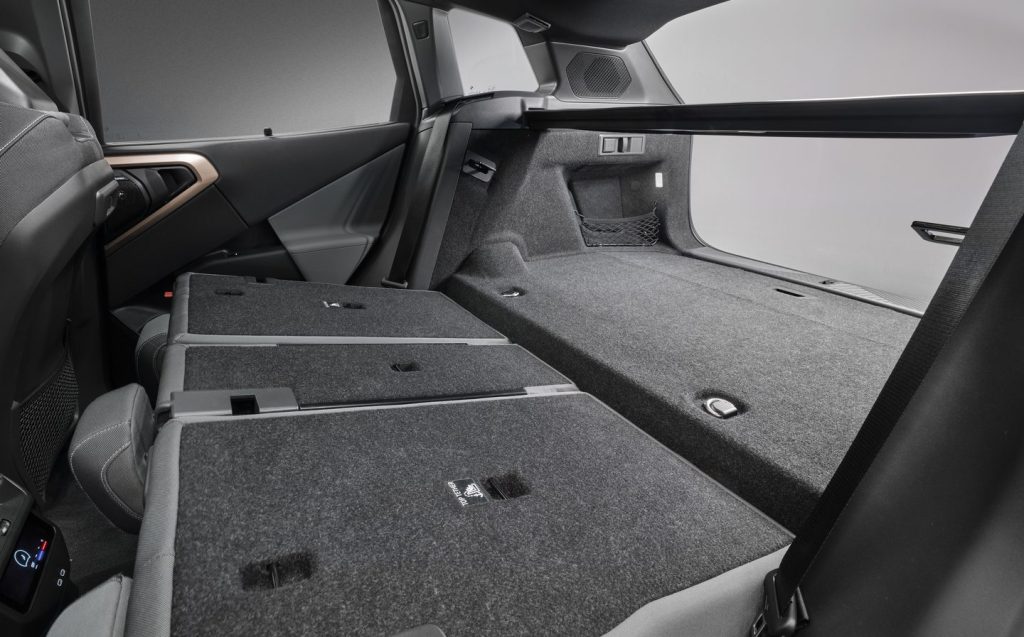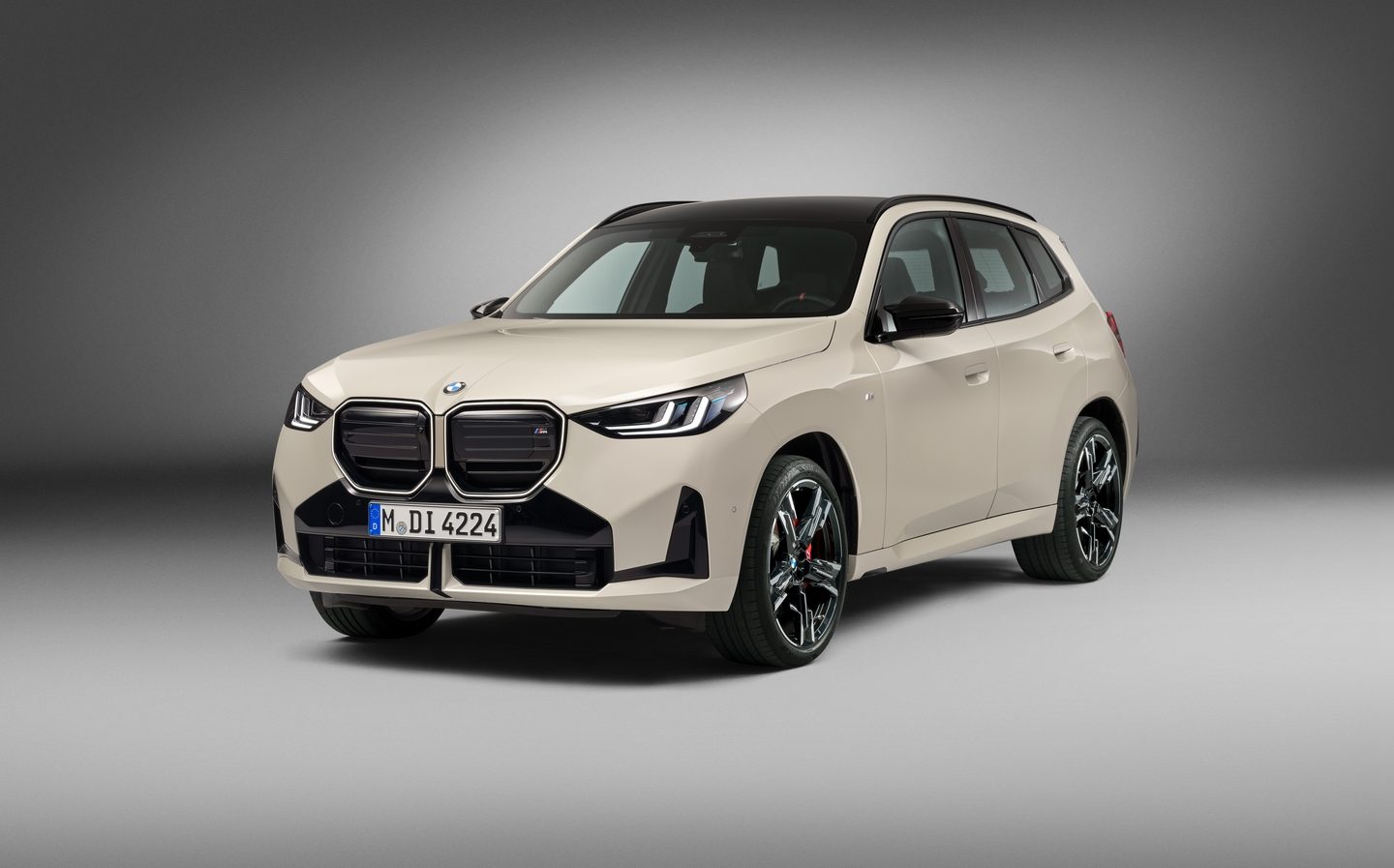All-new BMW X3 arrives – but not in electric form for now
Up to 56 miles on electric power in the PHEV
The BMW X3 was the company’s best-selling model globally last year, but despite its importance and mass-market appeal the German firm hasn’t been conservative in the style of the new, fourth-generation version, unveiled today.
As with any new BMW, attention is first drawn to the design of its “kidney” grille up front, as it’s a signifier of the brand, yet one with which it is happy to cause controversy.
For the X3, the previously-one-piece grille is split in two and in most models is blanked off with a distinctive series of horizontal and diagonal lines within. Buyers can emphasise the feature by upgrading to the ‘Iconic Glow’ option, which adds a continuous LED light around each portion.
LEDs are used as standard in the sleek headlights, which adopt a new L-shaped take on BMW’s traditional twin-lamp arrangement.

Focus on aerodynamics
Elsewhere, the new X3 is a little wider, lower and longer than before, to the benefits of its stance on the road and lower drag, the latter in the name of greater efficiency and noise reduction. For the same reason, there are flush-fitting door handles and the X3’s body is minimally adorned. This distances it from its predecessor in terms of style and means the vehicle is easier to recycle at the end of its life, according to BMW.

A curving roofline and relatively small tailgate window draw attention to rear lights, sitting in a greater expanse of painted body than before thanks to the movement of the number plate to the bumper. The M Performance model is the only one to get visible exhaust outlets.
Lots of engine choice from launch
From launch, there will be petrol, diesel and plug-in hybrid powertrain options. The entry-level X3 20 xDrive (BMW fans will note there is a slight change in the nomenclature) features a turbocharged 2-litre petrol engine making up to 205bhp, and yet is the slowest model in the range with a 0-62mph time of 7.8 seconds. All other versions of the new X3 feature an eight-speed automatic transmission and all-wheel drive.

Buyers worried that BMW was completely turning its back on diesel power (the 5 Series is no longer available with a diesel engine in the UK, and the same strategy has been applied to the updated 3 Series) will breathe a sigh of relief that there’ll still be an efficient long-distance X3 on the price list in the shape of the 20d xDrive variant.
It’s powered by the familiar twin-turbocharged 2-litre engine producing up to 194bhp, while its high torque output (peaking at 295lb ft) means it’s a tenth of a second quicker to 62mph than the petrol model. More importantly, the official fuel economy figure is as high as 48.7mpg.
At the other end of the scale is the new X3 M50 xDrive, referred to as an “M Performance vehicle” to make it clear that it sits below full-on M cars in the pecking order. Nonetheless, it still packs a punch thanks to its 3-litre straight-six petrol engine, making up to 392bhp and endowing the X3 with an impressive 4.6-second 0-62mph time.
This car gets several chassis enhancements to cope with the performance, including M Sport suspension and brakes, plus an electronically-controlled rear differential.
Plug-in hybrid goes further on a charge
There is no electric iX3 on the cards at this stage (that car will be replaced by the production version of the BMW Neue Klasse X concept), but BMW has revamped the plug-in hybrid model, the 30e xDrive. It can now drive up to 56 miles – according to WLTP conditions – using its battery and electric motor alone, resulting in a faintly ridiculous official fuel economy figure as high as 313.9mpg (expect much less in the real world, but it will depend wildly on how often it is plugged in).
When its 2-litre petrol engine is working with the electric motor, maximum power is a useful 295bhp, making it the second-fastest variant in the launch line-up. The battery can be recharged at up to 11kW on a suitable AC outlet, which is home wallbox speed.

Seemingly the only real disadvantage of the PHEV is a smaller boot, as the hybrid components underneath take up more space. It holds 460 litres with the rear seats in place, against 570 litres for the other cars in the range.
Those figures represent modest increases over the equivalent X3, however, and BMW has reshaped the boot floor of the PHEV so it’s a smooth transition from the lip rather than a distinct step as before.
In the main cabin, passenger space is comparable to the old X3’s as the new car’s wheelbase (distance between the centre of the front and rear wheels) is unchanged. BMW has lowered the internal floor to compensate for the lower roof, too.

Technology mixed with sustainability inside
As part of a renewed focus on sustainability, the X3’s new seats are upholstered in “Econeer” as standard, made from secondary material, while the dashboard can be finished in a knitted texture made from recycled polyester.
Veganza is BMW’s name for a synthetic leather alternative for the seats, while genuine leather is available only as a BMW Individual option.
The X3 is packed with BMW’s latest infotainment technology and features its Curved Display dashboard incorporating digital instrumentation and a large touchscreen. It also features a new take on the LED “Interaction Bar” first seen on the BMW 7 Series with prominent sections of LED lighting throughout the cabin.

UK retail pricing for the new X3 starts from £46,800 (for the X3 20 xDrive) and the standard specification includes three-zone climate control, electric tailgate opening and acoustic glazing. Both xLine and M Sport trim levels will be offered. The 20d model starts at £48,210, the PHEV from £56,340 and the range-topping M50 is priced at £64,990.
The new BMW X3 is available to order in the UK from today with first deliveries towards the end of 2024.
Related articles
- If you found news of the new BMW X3 interesting, you might want to read our review of the BMW i5 saloon
- You might also like to read our review of the BMW M3 Touring
- And don’t miss the new-look BMW 1 Series
Latest articles
- Seven great automotive events to visit this summer, from F1 to art and champagne
- Watch new Porsche 911 GT3 smash Nürburgring record for manual cars
- Skoda Elroq 2025 review: Czech carmaker can’t seem to miss with its electric family cars
- Five best electric cars to buy in 2025
- Should I buy a diesel car in 2025?
- F1 2025 calendar and race reports: The new Formula One season as it happens
- Zeekr 7X AWD 2025 review: A fast, spacious and high tech premium SUV — but someone call the chassis chief
- Denza Z9GT 2025 review: Flawed but sleek 1,062bhp shooting brake from BYD’s luxury arm
- Extended test: 2024 Renault Scenic E-Tech review


























